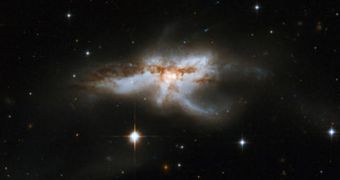It is common knowledge that active galaxies tend to include one or more stellar nurseries inside themselves. These are areas of intense stellar formations, where the conditions are just right for stars to form. The rate at which new suns are produced is entirely dependent on environmental factors, such as the amount of dust and gas present in the nursery, the amount of radiation and stellar winds emitted by surrounding, young, blue stars, and the chemical composition of the gas. The galaxies that feature the most stellar nurseries are called ultraluminous, because they shine with the same intensity of a trillion combined suns, or even more, PhysOrg reports.
The most luminous galaxies in the Universe are the infrared ultraluminous ones. Granted, they are not single structures. In fact, most of the times, astronomers say that what they construe to be a single such space structure at first later pans out to be a cosmic collision of several galaxies. To get an idea of exactly how bright these collision areas are, imagine that the massive Milky Way, our home galaxy, only shines for an outside observer with an intensity of roughly ten billion stars. The infrared ultraluminous variety does so a few orders of magnitude more intensely. In a new study, experts from the Harvard-Smithsonian Center for Astrophysics (CfA) wanted to determine if the same processes that underlay the formation of these bright galaxies were underway in the Milky Way as well.
According to the results of the investigation, it would appear that one of the primary sources for this level of brightness are stellar nurseries, and the massive gas clouds that power them up, more precisely. New stars are formed from this type of clouds, which over eons grow so large that they eventually collapse under their own weight, and then ignite. The thing is that the gas needs to be found in the nursery in massive amounts. Additionally, it needs to be left alone, undisturbed by things such as stellar winds and supernova explosions, which tend to disperse it, or modify its structure, and thus prevent new stars from being formed.
If these conditions are met, then the nursery will produce stars very fast, and in large numbers, the CfA team says. The new investigation was led by astronomer Desika Narayanan. What was further discovered was the fact that the huge accumulations of stellar gas, which are the trademarks of ultraluminous galaxies, appeared to form after two or more infrared galaxies started colliding with each other. In addition to mixing their stars and central supermassive black holes together, they also put their gas clouds together, boosting stellar-formation rates to incredible levels. Gas density is, in other words, the main factor dictating how a galaxy, or group of galaxies, produce(s) blue stars.

 14 DAY TRIAL //
14 DAY TRIAL //